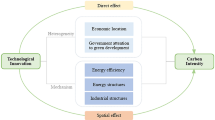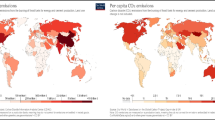Abstract
The problem of global climate change is a common problem faced by all countries, and develo** countries will face heavier pressure to reduce carbon emissions while promoting economic development. China is currently in a period of economic transformation, and the contradiction of industrial structure upgrading is becoming more and more prominent. The unreasonable industrial structure has caused a large consumption of resources, hindering the optimal allocation of resources and affecting carbon emissions. Technological innovation is an important force to cope with environmental changes, promote economic growth, and improve comprehensive competitiveness. Can technological innovation achieve carbon emission reduction under industrial structure upgrading? In this paper, industrial structure upgrading, technological innovation, and carbon emissions are studied together, and the impact of industrial structure upgrading, technological innovation on carbon emissions is theoretically analyzed, as well as how industrial structure upgrading acts on carbon emissions through technological innovation. An empirical test is conducted using 30 provincial panel data in China from 2005 to 2017, and it is found that industrial structure upgrading can reduce carbon emissions. An econometric analysis based on the mediating effect model finds that industrial structure upgrading has both a direct carbon emission reduction effect and a mediating effect of reducing carbon emissions through technological innovation, and the mediating effect of technological innovation in reducing carbon emissions remains significant in the regression analysis of sub-regions. Based on the research of this paper, it is suggested that the advanced development of industrial structure should be promoted, the rationalization of industrial structure should be promoted, the innovation development strategy should be firmly implemented, and the level of technological innovation should be promoted.
Similar content being viewed by others
Data availability
The datasets used and analyzed during the current study are available from the corresponding author on reasonable request.
References
Ab Iorwerth A (2005) Canada’s low business R & D intensity: the role of industry composition. Canada Department of Finance, Ottawa
Abramovay R (2010) Decarbonizing the growth model of Brazil: addressing both carbon and energy intensity. J Environ Dev 19(3):358–374
Ahmed V, Zeshan M (2014) Decomposing change in energy consumption of the agricultural sector in Pakistan. Agrar South J Polit Econ 3(3):369–402
Al-Ghandoor A, Al-Hinti I, Mukattash A et al (2010) Decomposition analysis of electricity use in the Jordanian industrial sector. Int J Sustain Energy 29(4):233–244
Brookes LG, Grubb M (1992) Energy efficiency and economic fallacies: a reply; and reply. Util Policy 20(5):390–393
Casler SD, Rose A (1998) Carbon dioxide emissions in the US economy: a structural decomposition analysis. Environ Resour Econ 11(3):349–363
Chen Z, Kahn ME, Liu Y et al (2018) The consequences of spatially differentiated water pollution regulation in China. J Environ Econ Manag 88:468–485
Cohen WM, Levinthal DA (1989) Innovation and learning: the two faces of R & D. Econ J 99(397):569–596
Fu H, Mao Y-S, Song L-S (2013) Empirical analysis on the effect of innovation on advancement of industrial structure process——based on panel datas of provinces from 2000 to 2011. China Ind Econ 09:56–68
Fu Y-P, Ma S-C, Song Q (2015) Spatial econometric analysis of regional carbon intensity. Stat Res 32(06):67–73
Gan CH, Zheng RG, Yu DF (2011) An empirical study on the effects of industrial structure on economic growth and fluctuations in China. Econ Res J 46(05):4-16+31
Gerlagh R (2007) Measuring the value of induced technological change. Energy Policy 35(11):5287–5297
Grübler A, Messner S (1998) Technological change and the timing of mitigation measures. Energy Econ 20(5–6):495–512
Gu A-L, He C-K, Lv Z-Q (2016) Industrial structure changes impacts on carbon emissions in China based on LMDI method. Resour Sci 38(10):1861–1870
Guo C-X (2012) Effect of industrial structure change on carbon emission in China. China Popul Resour Environ 22(07):15–20
Guo Y, Cao X-Z, Wei W-D, Zeng G (2022) The impact of regional integration in the Yangtze River Delta on urban carbon emissions. Geogr Res 41(01):181–192
Li K (2014) An empirical test on the relationship between industrial structure and carbon emission in China——an study based on dynamic panel smooth transition regression model. J Appl Stat Manag 33(03):381–393
Li W-Q, Nie X-Z (2015) Industrial upgrading and independent innovation: mechanistic analysis and empirical research. Stud Sci Sci 33(07):1008–1016
Liu LC, Fan Y, Wu G et al (2007) Using LMDI method to analyze the change of China’s industrial CO2 emissions from final fuel use: an empirical analysis. Energy Policy 35(11):5892–5900
Li J, Li X-P, Hao L-F (2021) Impact of dual environmental regulations on carbon emission intensity under the constraint of technological innovation. China Popul Resour Environ 31(9):34–44
Ma C, Stern DI (2008) China’s changing energy intensity trend: a decomposition analysis. Energy Econ 30(3):1037–1053
Schipper L, Murtishaw S, Khrushch M et al (2001) Carbon emissions from manufacturing energy use in 13 IEA countries: long-term trends through 1995. Energy Policy 29(9):667–688
Shen M, Li K-J, Qu R-X (2012) Technological progress, economic growth and carbon dioxide emissions: theoretical and empirical research. J World Econ 35(07):83–100
Sun L-W, Li Y-F, Ren X-W (2020) Upgrading industrial structure, technological innovation and carbon emission: a moderated mediation model. Technol Econ 39(06):1–9
Wang X-H, Zhen C (2012) An analysis of Shaanxi R&D input and optimization of industrial structure. Commer Res 06:25–30
Wang W-J, **ang Q-F (2014) Adjustment of industrial structure and the potential assessment of energy saving and carbon reduction. China Ind Econ 01:44–56
Wang G, Liu S(2020) Is technological innovation the effective way to achieve the “double dividend” of environmental protection and industrial upgrading?. Environ Sci Pollut Res 27(15): 18541–18556
Wang Z-X, Liang C, Zhao J-F (2012) Investment in science and technology performance, system environment and carbon emissions intensity. Sci Manag Res 30(06):109–112
Yang Y, Cai W, Wang C (2014) Industrial CO2 intensity, indigenous innovation and R&D spillovers in China’s provinces. Appl Energy 131:117–127
Yao C-S, Qian S-S, Li Z-C, Bai C-Q (2017) Relationship among agricultural carbon emission, science and technology input, and economic growth: a case study on Heilongjiang province. Chin J Agric Resour Reg Plan 38(08):8–15
Yuan F-H (2010) The potential economic growth of China with restraint of low carbon economy. Econ Res J 45(08):79-89+154
Zhang L, Li Y-M, Huang Y-X, Wu Y-M (2011) Analysis on character and potential of energy saving and carbon reducing by structure evolution in China. China Soft Sci 02:42–51
Zhang B-B, Xu K-N, Chen T-Q (2014) The influence of technical progress on carbon dioxide emission intensity. Resour Sci 36(03):567–576
Zhao Q (2018) Can the optimization and upgrading of industrial structure promote the efficiency of technological innovation? Stud Sci Sci 36(02):239–248
Zhao X, Long R-Y (2010) The status and decomposition model of carbon emissions for Jiangsu Province. China Popul Resour Environ 20(07):25–30
Zhou J-Q, Han Y, Zhang Y (2016) Independent R&D, industrial structure change and carbon emissions performance in China. Sci Technol Prog Policy 33(04):61–69
Zhu Y-B, Liu C-X, Wang Z, Shi Y-J (2013) Projection of industrial structure evolution and its carbon abatement potential for China. China Soft Sci 02:35–42
Author information
Authors and Affiliations
Contributions
**ngwang Zhu measured the carbon dioxide emissions of various regions in China, constructed the environmental regulation indicators used in the original manuscript, processed the data involved in the manuscript, explained the empirical results and put forward relevant suggestions, and finally translated the article. The author is the full contributor to the manuscript, the author reads and approves the final manuscript.
Corresponding author
Ethics declarations
Competing interests
The authors declare no competing interests.
Additional information
Responsible Editor: Eyup Dogan
Publisher's note
Springer Nature remains neutral with regard to jurisdictional claims in published maps and institutional affiliations.
Rights and permissions
About this article
Cite this article
Zhu, X. Have carbon emissions been reduced due to the upgrading of industrial structure? Analysis of the mediating effect based on technological innovation. Environ Sci Pollut Res 29, 54890–54901 (2022). https://doi.org/10.1007/s11356-022-19722-w
Received:
Accepted:
Published:
Issue Date:
DOI: https://doi.org/10.1007/s11356-022-19722-w




